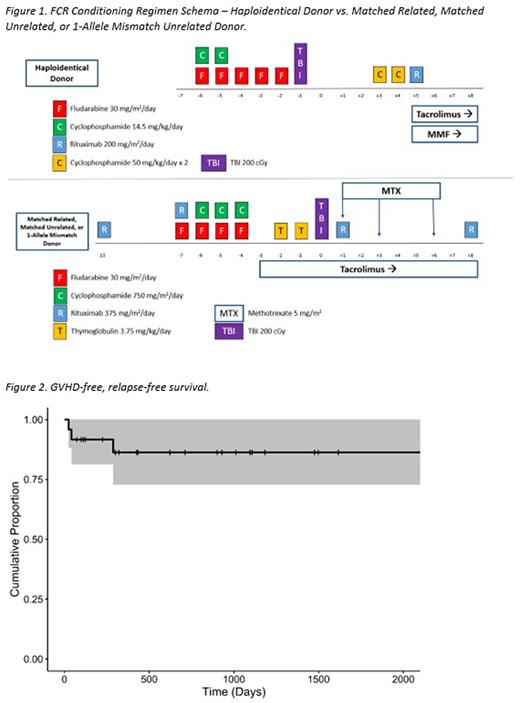Abstract

Introduction The distinct "age effect" that exists in severe aplastic anemia (SAA) following hematopoietic cell transplantation (HCT) favors the use of reduced intensity conditioning regimens in patients >40 years. For older adults, overall survival and disease-free survival (DFS) is reduced with increasing age and unrelated donor transplant are associated with higher rates of graft failure, Epstein-Barr virus (EBV) reactivation, and post-transplant lymphoproliferative disorders (PTLD) (Rice C, et al. BBMT 2019.). To overcome this, a novel, non-myeloablative conditioning regimen called FCR, which consists of fludarabine, cyclophosphamide, and rituximab, was designed at Vanderbilt University Medical Center (VUMC) and the associated VA Tennessee Valley Healthcare System (TVHS) for use in all SAA patients. This regimen was subsequently evaluated in the first 11 SAA patients treated at VUMC/TVHS and found to result in lower toxicity, graft-versus-host disease (GVHD), and viral reactivation with no graft failure or relapse compared to historical controls (Gatwood KS, et al. BMT 2018.). Given these initial favorable results, FCR has now been expanded as the preferred conditioning regimen for all SAA patients undergoing HCT at our center, warranting follow-up evaluation in a larger cohort.
Methods Utilizing institutional registries, all SAA patients were identified who underwent first allogeneic HCT using an FCR regimen (Figure 1) between January 2016 and May 2022. VUMC and TVHS Institutional Review Boards approved this retrospective analysis. Outcomes analyzed included time to engraftment, incidence of graft failure, incidence of acute GVHD (aGVHD) and chronic GVHD (cGVHD), rate of viral reactivation, post-HCT disease status, and number of inpatient hospital days through day +100. An analysis of 1-year GVHD-free, relapse-free survival (GRFS) was conducted in evaluable patients, with differences between the curves determined using log-rank tests.
Results Twenty-four SAA patients underwent HCT from January 26, 2016 to May 11, 2022, the majority of which were male with a median age of 43.5 years (range: 22-62). All patients received at least one line of therapy prior to HCT with the most common treatment being the combination of cyclosporin A with anti-thymocyte globulin with or without eltrombopag and/or corticosteroid. Median time from diagnosis to transplantation was 434.5 days (range: 84-6408). Patients received transplants from matched related (n=8), haploidentical (n=2), and matched unrelated donors (n=14) using either a peripheral blood (PB) or bone marrow (BM) stem cell source (PB=15, BM=9). Median time to neutrophil and platelet engraftment was 14 days (range: 10-25) and 18 days (range: 10-38), respectively. No patients experienced graft failure. At median follow-up of 806.5 days (range: 72-2180) post-transplant, all patients were alive and in remission. No patients developed grade III-IV aGVHD and no differences in grade I-II aGVHD rates were noted based on stem cell source. By date of last follow-up, mild to moderate cGVHD graded per 2014 NIH criteria developed in 7 and 3 patients, respectively. There were no cases of severe cGVHD. Only 2 patients experienced a viral reactivation (cytomegalovirus [CMV]=1, EBV=1) by date of last follow-up. The case of EBV reactivation did not require treatment and did not progress to PTLD. The median number of inpatient hospital days required post-engraftment through the first 100 days post-transplant was 5 days (range: 0-21). The unadjusted Kaplan-Meier estimate of 1-year GRFS was 86.3% (95% CI: 72.8%-100%) (Figure 2), with moderate cGVHD accounting for all GFRS events in the study cohort.
Conclusions The use of our novel non-myeloablative conditioning regimen in SAA is well tolerated with 0% non-relapse mortality and 100% DFS with low GVHD rates at 1-year post-transplant. Despite a high-risk population with median age >40 years, using primarily matched unrelated donors, and majority peripheral blood stem cell source, there were no deaths and rates of complications remained low. This study further supports the findings of our previous study, redemonstrating low rates of toxicity, severe GVHD and viral reactivation with no graft failure, relapse, or mortality. The use of these regimens needs to be validated in a larger cohort as they have the potential to provide a new standard of care for pre-HCT conditioning in SAA patients.
Disclosures
Shultes:Oncology Times: Honoraria. Sengsayadeth:Amgen: Research Funding. Kim:Nextcure: Research Funding; Agenus: Consultancy. Dholaria:Angiocrine: Research Funding; Orca Bio: Research Funding; MJH Biosciences: Honoraria; Vanderbilt University Medical Center: Current Employment; Pfizer: Research Funding; Wugen: Research Funding; Poseida: Research Funding; Jazz Pharmaceuticals: Consultancy; Janssen: Research Funding; Gamida Cell: Consultancy; MEI Pharma: Research Funding; Molecular Templates: Research Funding; BMS: Research Funding; Takeda: Research Funding; BEAM Therapeutics: Consultancy; Arivan: Consultancy. Gatwood:Jazz Pharmaceuticals: Speakers Bureau; AstraZeneca: Research Funding; Kite Pharma: Speakers Bureau; sanofi: Speakers Bureau.
OffLabel Disclosure:
Fludarabine, cyclophosphamide, and rituximab in combination for conditioning of patients with severe aplastic anemia prior to stem cell transplantation
Author notes
 This icon denotes a clinically relevant abstract
This icon denotes a clinically relevant abstract
Asterisk with author names denotes non-ASH members.


This feature is available to Subscribers Only
Sign In or Create an Account Close Modal